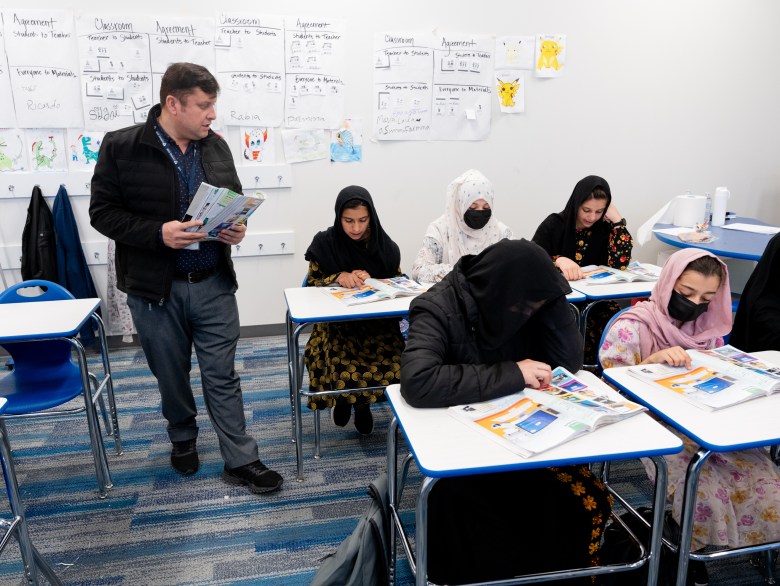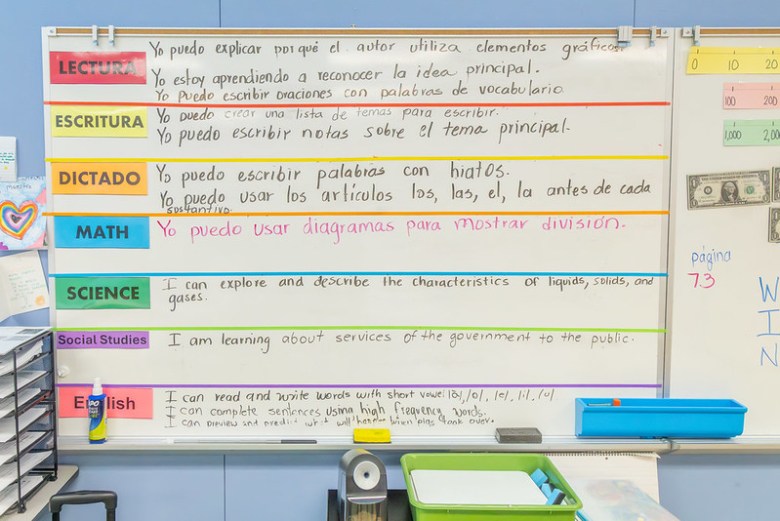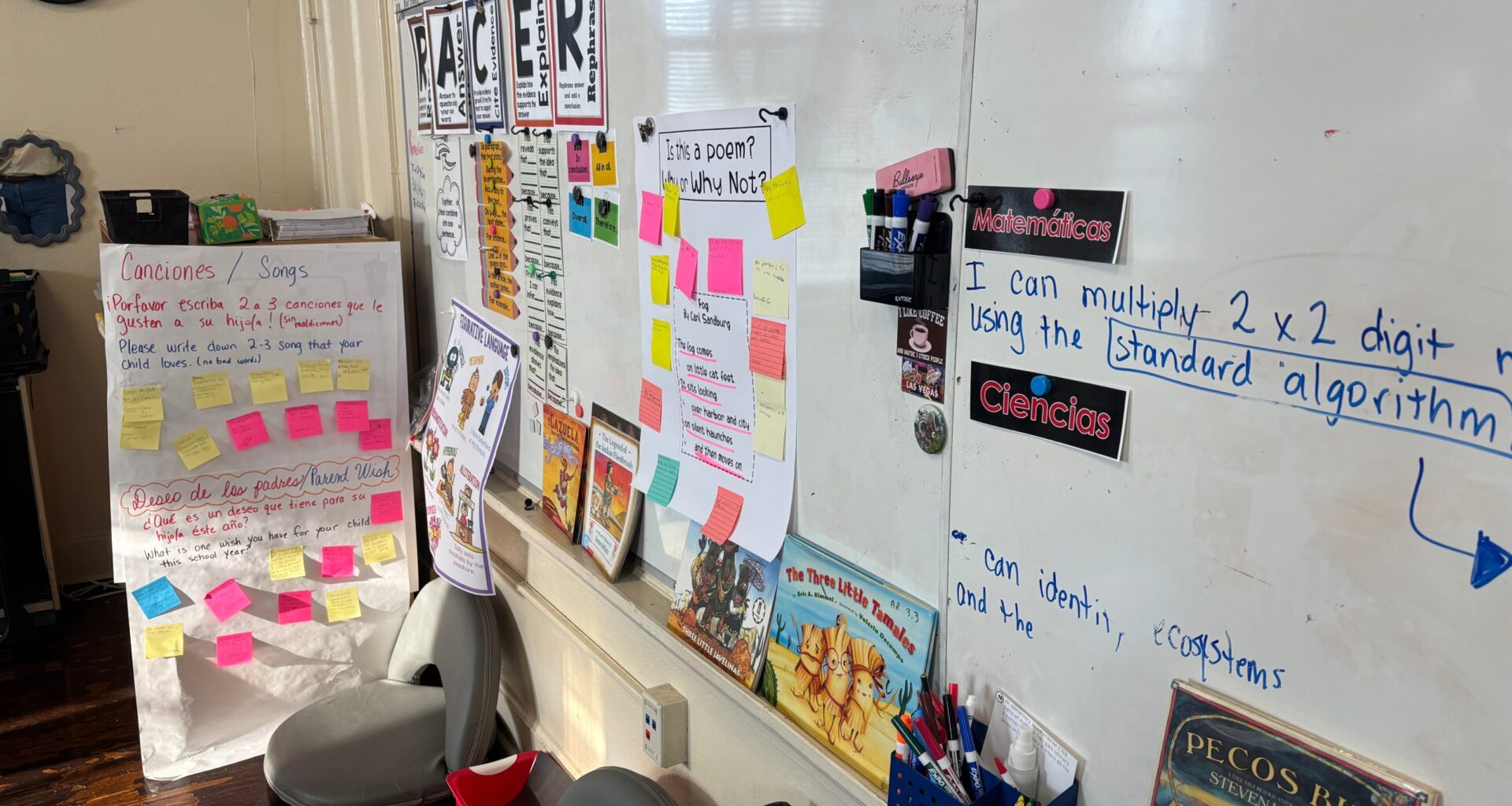As dual language programs expand, San Antonio schools currently face a shortage of fully certified bilingual and English-as-a-second-language teachers.
This comes after a surge in emergent bilingual students — those in the process of learning English as a second language — in recent years.
Every year, school districts are required to evaluate their bilingual and ESL programs, measuring their effectiveness in teaching students and how many teachers still need additional language certifications.
School districts then apply for bilingual exemptions and ESL waivers from the state for non-certified teachers along with professional development plans for those staff.
Alicia Alvarez-Calderon is the senior director for bilingual and ESL programs at North East Independent School District, which recently submitted applications for 10 bilingual exemptions and 135 ESL waivers.
“We don’t have that many people that speak the language fluently that can actually seek that bilingual certification,” Alvarez-Calderon said.
Bilingual certifications require teachers to be fluent in English and the language they’re teaching, and have to pass multiple exams, on top of having a general education certification.
“It’s not an easy one,” Alvarez-Calderon described the bilingual certification.
Similarly, ESL teachers have to take several certification exams in addition to their regular teaching license, but they are not required to fluently speak another language outside of English.
Effects of immigration
The number of emergent bilingual students has steadily increased at North East ISD while the district’s overall enrollment has steadily decreased.
Alvarez-Calderon, who’s been with the district for 13 years, said there’s several reasons for North East’s growing number of emergent bilingual students. For starters, students who don’t reclassify as fluent in English show up again on the district’s emergent bilingual count.
Two years ago, the district was receiving a large number of refugee students from the Middle East, at one point getting an influx of between 600 to 700 new immigrant students in one school year across all grade levels.
During the 2022-23 school year, North East had an emergent bilingual population of 10,820. The next year, the district had 11,500. During the 2024-25 school year, the count went up to 11,700.
“But we have not seen as many refugees in the past two years,” she said. Most of the incoming emergent bilingual students from the last two years have been immigrants from Nicaragua, Venezuela and Cuba.
While it’s easier to teach students from Spanish-speaking countries, Alvarez-Calderon says several of these students often enter the district with very little or lapsed schooling because they likely spent months or years on their journey into the country.
To make up for these gaps, NEISD offers Saturday school for struggling emergent bilingual students to accelerate instruction.
Aside from Spanish, the most common languages North East emergent bilingual students speak at home are Pashto, Vietnamese and Arabic.
 Ismail Ja Khosti teaches English as a Second Language (ESL) at Compass Rose Dream in January 2024. Credit: Brenda Bazán / San Antonio Report
Ismail Ja Khosti teaches English as a Second Language (ESL) at Compass Rose Dream in January 2024. Credit: Brenda Bazán / San Antonio Report
Dual language programs grow
North East recommends all emergent bilingual students who primarily speak Spanish enroll in dual language programs instead of ESL programs because developing a student in their native tongue makes it easier to learn a new language.
Emergent bilingual students in dual language programs tend to outperform emergent bilinguals in general education classrooms on state tests.
A comparison of San Antonio school districts
Southwest ISD
- 64 ESL waivers
- 1 bilingual exemption
- About 2,800 emergent bilingual students (19% of student enrollment)
Southside ISD
- 6 bilingual exemptions during the 2024-25 school year
- 1,500 emergent bilingual students (25% of student enrollment)
East Central
- 3 bilingual exemptions
- About 50 ESL waivers
- 1,550 emergent bilingual students (14% of student enrollment)
Last year, 64% of emergent bilingual middle schoolers in dual language classes at North East approached or met grade level requirements on the social studies STAAR, compared to 32% of emergent bilingual students in regular classrooms. Similar discrepancies can be seen for other STAAR exams.
Over at Harlandale ISD, the need for bilingual exemptions has increased while ESL waivers have decreased.
In a recent district meeting, Harlandale’s bilingual coordinator Mario Ferron said the number of bilingual exemptions has steadily increased for years. In 2022, the district applied for three bilingual exemptions across three schools; this year, Harlandale will apply for 13 exemptions at six campuses.
“[Exemptions] are increasing because our number of emergent bilingual students are increasing,” Ferron explained.
The need for ESL waivers decreased, however. In 2022, Harlandale had 53 teachers without an ESL supplemental, but this year the district only has 27, despite the growing number of emergent bilingual students.
The district had about 2,460 emergent bilingual students during the 2024-25 school year. This year, Harlandale estimates a group of 2,550 emergent bilinguals, accounting for 23% of its enrollments.
Emergent bilingual students make up an even larger share of Harlandale’s preschool students. Last year, they made up 27% compared to 44% of pre-K students for the 2025-26 school year.
Following the growth of dual language classes, the number of emergent bilingual students who reclassify has also increased going from 121 to 195 in one school year.
 The lesson plans inside dual language classroom at Regency Place Elementary School in NEISD. Credit: Courtesy of North East ISD
The lesson plans inside dual language classroom at Regency Place Elementary School in NEISD. Credit: Courtesy of North East ISD
Changes to language testing
It may take longer for students to reclassify in the future, given the state’s recent change to the Texas English Learning Proficiency Assessment System (TELPAS) which all emergent bilingual students are required to take.
The Texas Education Agency is expanding the levels of growth that measure where a bilingual student is on their journey to acquire English. There are currently four proficiency levels, but the new system will have five.
Alvarez-Calderon said the new system won’t affect how students are taught, but she expects it will take longer for students to reclassify.
The longer process isn’t necessarily a bad thing for students, however, since bilingual education experts say it takes about five to seven years for students to reach academic language proficiency. It’s more realistic, said Ferron, compared to the shortened timeline the state currently has for reclassification.
“There was this false expectation that the students should have been moving from one proficiency level every year,” he said. “Now the state is giving us five years to reach that level of proficiency.”
The new system won’t go into effect until the 2026-27 school year.
Solutions to bilingual teacher shortage
San Antonio follows a similar trend statewide, where the amount of emergent bilingual students has gone from 21% to 24% of Texas students in recent years.
Across the state, there are more than 20,000 bilingual classrooms without certified bilingual teachers.
To deal with the shortage of certified bilingual and ESL teachers, school districts have employed tactics from offering stipends to using international teaching programs.
Harlandale ISD took advantage of the state’s Visiting International Teachers program and currently has five teachers from Spain. It also offers competitive pay stipends for teachers with certifications and recruiters often travel across the state.
San Antonio ISD, where a quarter of students are emergent bilingual, has seen a 39% decrease in bilingual exemptions. To deal with the certification exam issues, SAISD waives testing fees for non-certified bilingual teachers.
“Fewer bilingual exemptions this year are due to better recruitment, retention, and classroom adjustments,” said district spokesperson Laura Short.
While school districts deal with shortages, certified and non-certified teachers can also be equally effective, Ferron said.
Non-certified teachers receive additional training. Curriculum and instruction plays a significant role in teaching students English proficiency.
Harlandale ISD is one of only a handful of school districts in Texas who adopted the language arts portion of Bluebonnet Learning, a state-created curriculum that’s been criticized for leaning too heavily on stories from the Christian Bible. The district adopted the English and Spanish versions of the curriculum, and its bilingual department is currently working to tie both versions together for dual language classrooms.
Ferron said the district is expecting better reading scores after Bluebonnet is fully implemented as a dual language curriculum.
“When the students are able to read in their first language that will facilitate the development of the second language,” he said. “That’s the beauty and the difference that a dual language program brings.”
